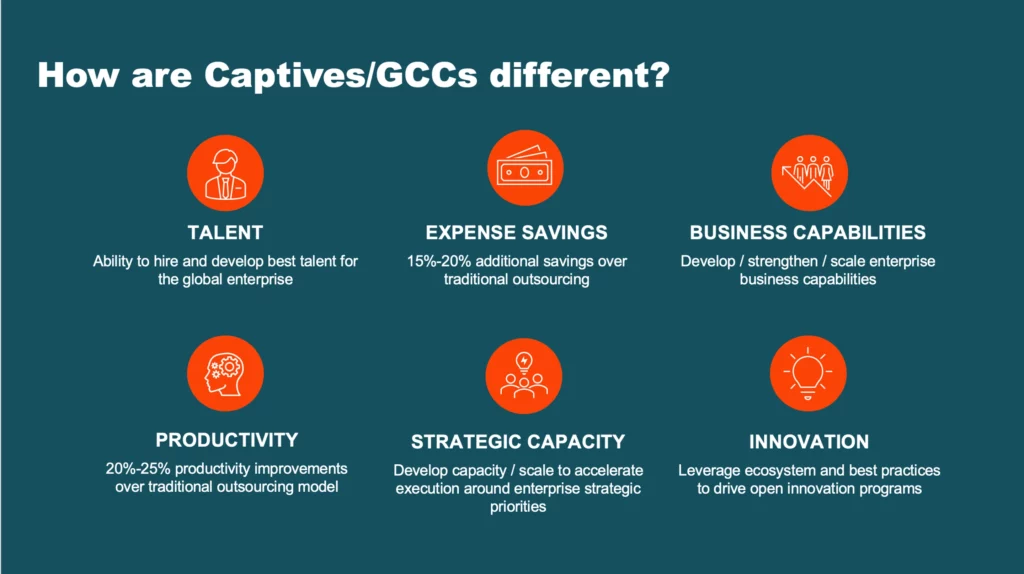Captive Centers in India : Maximize Business Efficiency with Offshore Captive Center Solutions
Captive centers, also known as global in-house centers or global capability centers (GCCs) are client-owned, client-operated delivery centers. Global Captive centers typically function in a non-domestic, talent-rich and low-cost location, providing business-critical outcomes directly to the parent company. Initially, these captives provided back-office or customer support, and product innovation or data and analytics support hardly ever took place. Today, offshore captive centers are driving the transformation agenda of their parent organizations. The employees in a global captive center are legal employees of the organization, not the vendor.
A Global Captive Center Can:
– Deliver strategic, cross-functional business capabilities to the enterprise
– Overcome a distributed technology landscape with cross-functional scale and digital capabilities and tools
– Focus on customer and user experience, not just on efficiency
Captive Landscape and Trends
Impact of COVID-19
In a recent article, McKinsey reported that offshore captive centers have successfully adapted to pandemic disruptions and have maintained (and even exceeded) service levels. Best-in-class global captives have also recovered to their pre-crisis baseline across key metrics — resiliency, business continuity, and productivity/ efficiency.
Innovating Innovation
Offshore captives are successfully leveraging talent and workplace diversity in support of enterprise innovation agenda – embedding innovative business and product ideas across company service lines.
From startup led open innovation programs to innovation labs & intrapreneurship programs, captive offshoring is successfully executing on an omnichannel approach for a robust and sustainable foundation.
Business Focus
From traditional service delivery centers, global captives are now being developed as alternate business locations – complete with business leaders, functional ownership and focus on business impact, competitiveness and differentiation.
The Evolving Captive Landscape in India
A survey by NASSCOM recently found that by 2025, MNCs are likely to set up 500 new Global Captive Centers (GCCs) in India. Until two years ago, the number of such units established annually was around 50. This in-house offshoring demonstrates that India’s large talent pool continues to be attractive and grow.
Year | 2009 | 2017 | 2022 |
Captive Centres in India | 900+ | 1,100+ | 1,400+ |
Employees | 3,90,000 | 8,00,000 | 13,00,000 |
Revenue | $10.6 B | $23 B | $33.8 B |
Global Captive centers have successfully evolved into enterprise CoE teams for accelerating the technology adoption and enterprise transformation undertaking work in areas including digital, advanced data analytics, mobility, AI/ cognitive & automation.

Evolving from Back-office to Global Captive Centers/GCCs
Historically viewed as an attractive source of ‘cost arbitrage,’ the raison d’etre of a global captive center is now changing to one of ‘skills arbitrage’ or ‘intellectual arbitrage,’ with more recent Captives set up to deliver tech skills at scale, and drive product innovation at a cost advantage. Nowadays, Captive Centers or Global Capability Centers can support a range of critical business goals. They serve as ‘centers of excellence’ specializing in areas like data analytics; as product or process innovation hubs; or they perform broader functions using the technology required for hybrid work.
Key Reasons why Enterprises Set Up Offshore Captive Centers
Enterprise talent: The ability to hire and develop best talent for the global enterprise
Business capabilities: Develop, strengthen and scale enterprise centres of excellence in areas such as cloud, mobile, RPA, AI and Analytics.
Productivity: Captive offshoring/GCC model is 20%-25% more productive over the traditional outsourcing model.
Strategic capacity: Develop capacity and scale to accelerate execution around enterprise strategic priorities
Innovation: Leverage start-up ecosystem and best practices to drive open innovation programs through a captive offshore model
Expense savings: Captive offshoring/GCC model offers 15%-20% additional savings over traditional outsourcing
Read more about the various aspects and differences here.

Conclusion
Global captive centers have a tremendous opportunity to play a more strategic role for their enterprises. Making this shift calls for collective efforts from the enterprise and the leadership team at the offshore captive center to align the goals and operational priorities for the captive center and manage the constraints of growing complexity and a traditional back-office mindset.
To explore in-depth analysis, trends, and expert insights on captive centers, visit our Captive Center Insights page. Learn how organizations are leveraging captive centers to drive innovation and operational efficiency.




